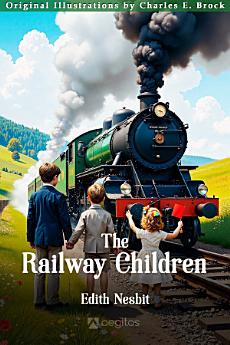The Railway Children
About this ebook
The children's curiosity and resourcefulness are showcased as they befriend railway workers, engage in exciting escapades, and gradually uncover secrets surrounding their father's absence.
The novel masterfully portrays themes of family resilience, the power of friendship, and the importance of unwavering hope in the face of adversity. While ostensibly a children's story, its underlying themes of loyalty, social injustice (hinted at through the father's situation), and the beauty of simple pleasures resonate deeply with readers of all ages.
The idyllic setting of the Yorkshire countryside, with its bustling railway and vibrant community, adds to the story's enduring appeal. Nesbit's writing style is simple yet evocative, capturing the children's perspectives with accuracy and creating a nostalgic, almost timeless quality. Though the plot might appear somewhat simplistic on the surface, the novel offers subtle explorations of class dynamics and the complexities of adult relationships, making it a rewarding read for both children and adults.
The Railway Children is a heartwarming tale of family, friendship, and the enduring spirit of childhood, leaving a lasting impression of optimism and hope.
About the author
Edith Nesbit (1858-1924) was a distinguished British author, celebrated for her enduring contributions to children's literature. Born in 1858, London, to a family situated within an intriguing blend of Irish and British heritage, Nesbit's early life was colored by both prosperity and subsequent financial difficulty, primarily due to her father's financial mismanagement and early demise. These experiences of hardship and resilience informed her storytelling, imbuing it with themes of endurance, the healing capacities of kindness and imagination, and the complexities of human relationships.
Nesbit's formative years were marked by her education at home, attributed to her delicate health as a child. This self-directed learning, encompassing a significant amount of reading and writing, sparked her eventual pivot towards literature. Her marriage to Hubert Bland influenced her literary trajectory profoundly, propelling her towards writing children's fiction, although by that time, she had already engaged in socialism and participated in avant-garde circles, shapes that enriched her narrative depth and thematic emphasis.
Nesbit's bibliography boasts seminal works in children's literature, notably The Railway Children (1906), Five Children and It (1902), The Enchanted Castle (1907), and The Story of the Amulet (1906). Her narrative style amalgamates realism with elements of fantasy, frequently set against the nuanced backdrop of Edwardian England. Nesbit's genius lay in her ability to infuse everyday settings with elements of wonder and adventure, effectively elevating the ordinary to the extraordinary, while also bravely addressing the psychological realities and societal critiques reflective of her own times.
Uniquely, Nesbit offered narratives that presented children not just as innocents navigating fairy tales but as entities grappling with real-world challenges, deploying cleverness, moral integrity, and creativity to overcome adversity. This approach not only set her apart from her contemporaries but also paved the way for future writings, influencing literary giants such as J.R.R. Tolkien, C.S. Lewis, and J.K. Rowling, who have acknowledged her impact on their work.
Beyond her narrative contributions, Nesbit's activism and involvement with the Fabian Society reflect her deep-seated commitment to social reform, a passion subtly laced through her writings. Through her life's work, Nesbit affirmed storytelling's immense capacity for inspiration, introspection, and change. Her literary legacy is a celebration of the imagination's power, the complexities inherent in childhood, and the indelible nature of kindness, continuing to resonate and inspire across generations.
Edith Nesbit's own life story, intertwined with personal loss, including those endured during World War I and her battle with breast cancer, parallels the themes of fragility and resilience that permeate her work. She passed away on May 4, 1924, leaving behind a rich tapestry of literature that continues to engage, entertain, and illuminate readers worldwide.








